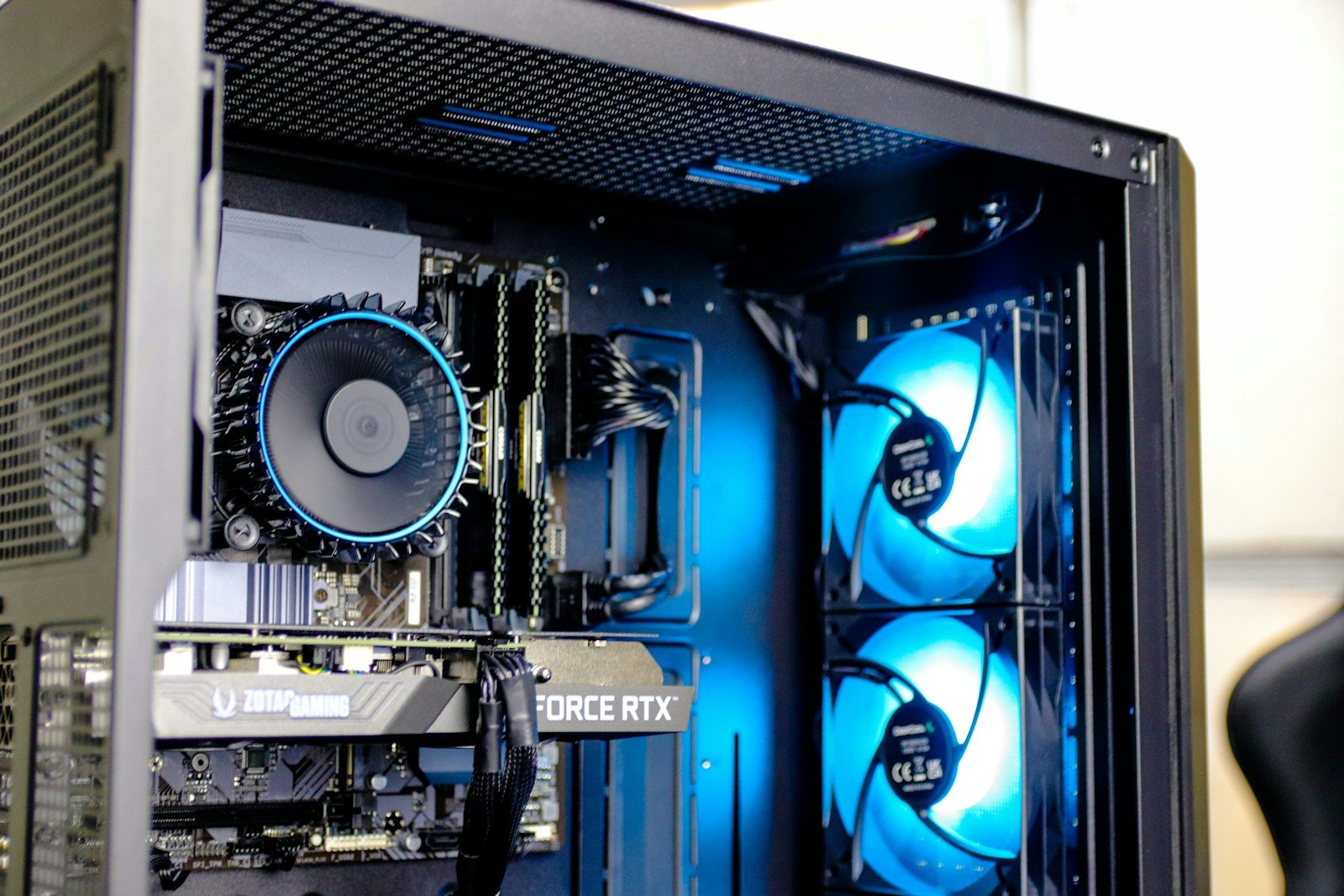Keeping your CPU temperature in check while gaming is essential for your computer’s performance and longevity. Many gamers worry when they see their temperatures rise during intense gaming sessions, but understanding normal ranges can help ease these concerns. CPU temperatures between 60-80°C during gaming are generally considered normal and safe, with some high-performance processors like the Intel 13700K naturally running hotter than others.
Your CPU cooling setup plays a significant role in managing these temperatures. Stock coolers that come with processors typically allow temperatures to reach up to 80°C under load, which is acceptable. If you’re seeing temperatures consistently above 90°C, however, that’s when you should consider taking action to improve your cooling solution.
Ambient room temperature also affects your CPU’s performance. A warmer room can increase your baseline temperatures by several degrees. This is why some gamers notice seasonal changes in their system’s thermal performance, with higher temperatures during summer months even with the same gaming habits.
What Is a Normal CPU Temperature While Gaming?
According to multiple hardware experts:
- Normal CPU temperature while gaming: 70°C – 85°C (158°F – 185°F)
- Safe idle temperature: 35°C – 50°C (95°F – 122°F)
- Maximum safe limit: 90°C – 100°C (194°F – 212°F) (depends on CPU model)
💡 Most modern CPUs are designed to handle temperatures up to around 100°C, but consistent operation above 85°C can reduce lifespan and trigger thermal throttling.
Source: ComputerCity, TheDroidGuy, GadgetMates
🧩 Typical Temperature Ranges by CPU Type
| CPU Type | Idle Temp | Gaming Temp | Max Safe Temp |
|---|---|---|---|
| Intel Core i5 / i7 / i9 (12th–14th Gen) | 35–45°C | 70–85°C | 100°C |
| AMD Ryzen 5 / 7 / 9 (5000–7000 Series) | 35–50°C | 70–85°C | 95°C |
| Laptop CPUs (Intel or AMD) | 40–60°C | 75–90°C | 100°C |
| Older CPUs (Pre-2018) | 40–55°C | 65–80°C | 90°C |
⚠️ Laptop CPUs tend to run hotter due to compact cooling systems.
🔍 How to Check Your CPU Temperature
You can monitor CPU temps in real time using free tools:
Windows:
- HWMonitor – Detailed temperature and voltage readings.
- Core Temp – Simple and lightweight.
- MSI Afterburner – Great for gamers; shows temps in-game overlay.
macOS:
- iStat Menus or Macs Fan Control.
Linux:
- Use the
sensorscommand (after installinglm-sensors).
⚙️ Factors That Affect CPU Temperature
- CPU Load – Gaming, rendering, and multitasking increase heat output.
- Cooling System – Air vs. liquid cooling makes a big difference.
- Case Airflow – Poor ventilation traps hot air inside.
- Thermal Paste Quality – Old or poorly applied paste reduces heat transfer.
- Ambient Room Temperature – Hot environments raise baseline temps.
- Overclocking – Boosts performance but also increases heat output.
(Source: TechGuideLab)
🧊 How to Keep CPU Temperatures Low
1. Improve Airflow
- Clean dust filters and fans regularly.
- Ensure intake and exhaust fans are properly oriented.
- Use a positive pressure setup (more intake than exhaust) for optimal cooling.
2. Upgrade Your Cooling
- Consider a better air cooler (e.g., Noctua, be quiet!, Cooler Master).
- For high-end CPUs, AIO liquid coolers (120mm–360mm) can drop temps by 10–20°C.
3. Reapply Thermal Paste
- Replace every 1–2 years or if you notice rising temps.
- Use high-quality paste like Arctic MX-6 or Thermal Grizzly Kryonaut.
4. Adjust Fan Curves
- In BIOS or software like MSI Afterburner, increase fan speed at higher temps for faster cooling.
5. Avoid Overclocking (or Undervolt)
- Overclocking increases heat; undervolting can lower temps without losing performance.
6. Manage Ambient Temperature
- Keep your PC in a cool, ventilated area.
- Avoid placing it in enclosed spaces like desks or cabinets.
🧠 What Happens If Your CPU Overheats?
If your CPU exceeds its safe temperature limit:
- Thermal throttling occurs — the CPU slows down to reduce heat.
- System instability — crashes or freezes during gaming.
- Reduced lifespan — prolonged exposure to high temps can degrade components.
- Automatic shutdown — built-in protection kicks in to prevent damage.
🧮 Quick Reference: Ideal CPU Temps by Usage
| Usage Type | Ideal Temperature Range |
|---|---|
| Idle / Light Tasks | 35°C – 50°C |
| Browsing / Streaming | 45°C – 65°C |
| Gaming / Heavy Load | 70°C – 85°C |
| Rendering / Stress Test | 80°C – 90°C |
| Critical (Reduce Load Immediately) | 90°C+ |
✅ Final Thoughts
A normal CPU temperature while gaming typically falls between 70°C and 85°C.
Anything below 85°C is safe, while temperatures consistently above 90°C indicate a cooling issue that needs attention.
By maintaining proper airflow, using quality cooling hardware, and monitoring your temps regularly, you can ensure your CPU stays healthy — giving you smooth gaming performance and long-term reliability.
📚 References
- ComputerCity – Ideal CPU and GPU Temperature Range Charts
- TheDroidGuy – Optimal CPU Temp for Gaming
- GadgetMates – Normal CPU and GPU Temperatures for Your PC
- TechGuideLab – Normal CPU Temperature During Gaming
- Hone Blog – Optimal CPU Temp While Gaming
Key Takeaways
- Normal CPU temperatures while gaming typically range from 60-80°C, with concern warranted only when consistently exceeding 90°C.
- Different CPU models have varying temperature profiles, with newer high-performance chips often running hotter than older or lower-tier models.
- Proper cooling solutions and good case airflow can significantly improve temperature management during extended gaming sessions.
Understanding CPU Temperatures
CPU temperature is a critical factor in maintaining your gaming PC’s performance and longevity. Knowing what temperatures are normal helps you avoid potential hardware damage and performance issues.
Factors Affecting CPU Temperature
CPU temperatures are influenced by several key elements. The quality of your processor’s build plays a significant role, as higher-end CPUs often include better materials for heat dissipation.
Room temperature directly impacts how hot your CPU runs. A computer in a 75°F room will naturally run hotter than one in a 65°F environment.
Case airflow is crucial for heat management. Poor ventilation traps hot air around components, while good airflow helps maintain lower temperatures.
The CPU cooler type makes a substantial difference. Stock coolers that come with processors typically allow higher temperatures than aftermarket air coolers or liquid cooling solutions.
CPU usage also matters. Gaming and other intensive tasks push processors to work harder, generating more heat than when idle.
AMD vs. Intel Temperature Ranges
AMD and Intel CPUs have different temperature tolerances. Intel processors typically run at 45-55°C when idle and can reach 70-80°C during gaming sessions.
AMD processors often run slightly hotter by design. Idle temperatures between 40-60°C are normal, while gaming temperatures of 70-85°C are generally acceptable.
The thermal junction maximum (TJMax) differs between brands. Most modern Intel CPUs have a TJMax around 100°C, while AMD Ryzen processors typically throttle at 95°C.
These differences stem from chip architecture and manufacturing processes. Neither is inherently better; they simply have different thermal characteristics that are accounted for in their design.
Identifying Normal Operating Temperatures
For most gaming CPUs, idle temperatures between 30-50°C indicate proper cooling. This range varies based on ambient temperature and cooler quality.
During gaming sessions, temperatures between 60-80°C are considered normal. Readings consistently above 85°C might warrant investigation, though brief spikes are generally not concerning.
Different monitoring tools may show varying temperature readings. Software like HWMonitor, Core Temp, or NZXT CAM can help track your CPU’s thermal performance.
Temperature concerns should arise when your CPU regularly exceeds 90°C during gaming. At this point, thermal throttling may occur, reducing performance to prevent damage.
The age of your CPU cooler matters too. Thermal paste degrades over time, potentially causing higher temperatures in older systems even with the same usage patterns.
Optimizing Your Gaming Setup for Ideal CPU Temperatures
Keeping your CPU at a safe temperature during gaming sessions requires a thoughtful approach to your computer setup. The right combination of cooling hardware, proper airflow management, and optimized power settings can make a significant difference.
Choosing the Right Cooling Solutions
CPU cooling comes in several forms, each with different capabilities for managing heat. Air coolers use a heatsink and fan to draw heat away from the processor. They’re affordable and reliable for most gaming needs.
Liquid cooling systems offer superior performance for high-end gaming rigs. These systems circulate coolant through a closed loop to transfer heat away from the CPU more efficiently than air coolers.
For gaming laptops, cooling options are more limited. Cooling pads can help by providing additional airflow beneath the laptop. Some models include built-in fans that blow cool air directly onto the laptop’s underside.
Thermal paste application is crucial regardless of cooling type. This substance fills microscopic gaps between the CPU and heatsink, improving heat transfer. Replacing old, dried thermal paste can lower temperatures by 5-10°C.
The Importance of Airflow
Good airflow is the foundation of effective cooling. Computer cases should follow a clear path for air to enter, pass over hot components, and exit without obstruction.
Case fans should be arranged in a balanced intake and exhaust configuration. The standard approach places intake fans at the front and bottom, with exhaust fans at the rear and top.
Cable management plays a surprising role in temperature control. Tangled or poorly routed cables can block airflow paths and create hot spots inside the case.
Dust accumulation severely impacts cooling performance. Regular cleaning of fans, heatsinks, and filters helps maintain optimal airflow. Even a thin layer of dust can act as insulation, trapping heat near components.
Gaming laptops benefit from elevated positioning. Raising the rear of the laptop creates space underneath for better air circulation and prevents the bottom vents from being blocked.
Managing Power Settings and Fan Speed
Windows 10 power settings directly affect CPU temperatures. The “Balanced” or “Power Saver” plans can reduce heat output during less demanding tasks by limiting maximum processor usage.
Fan control software allows users to create custom fan curves. These tools let gamers increase fan speeds during intensive gaming sessions and reduce them during quieter moments for less noise.
Undervolting reduces the CPU’s power consumption without sacrificing performance. This technique can lower temperatures by 5-15°C on many systems, though it requires careful testing.
Some games are more CPU-intensive than others. Limiting frame rates in these games can prevent unnecessary CPU load, reducing heat generation while maintaining smooth gameplay.
For laptop gamers, external cooling becomes essential during extended sessions. Besides cooling pads, keeping the gaming environment itself cool and ensuring the laptop’s vents remain unobstructed will help maintain safe temperatures.
Troubleshooting and Preventing Overheating
When your CPU temperatures rise too high during gaming sessions, it’s essential to take action quickly. Proper cooling maintenance and preventive measures can help maintain safe CPU temperatures and extend the life of your computer.
Detecting Symptoms of Overheating
High CPU temperatures often reveal themselves through noticeable symptoms. If your computer suddenly shuts down during gameplay, experiences random freezes, or shows significant performance drops, overheating may be the culprit.
Most modern computers display warning messages when temperatures exceed safe levels, typically above 80°C. Gaming laptops and desktops should ideally maintain temperatures between 50-67°C during intense gaming sessions.
Frame rate drops and stuttering can also indicate thermal throttling, where the CPU reduces performance to lower temperatures. System crashes become more frequent as temperatures climb into dangerous ranges.
Warning signs of CPU overheating:
- Unexpected shutdowns
- Performance stuttering
- Loud fan noise
- Blue screen errors
- Reduced frame rates
Regular Maintenance for Sustained Performance
Dust accumulation is the primary enemy of proper cooling. Cleaning CPU heatsinks and fans every 3-6 months helps maintain optimal airflow. Compressed air can remove dust without damaging components.
Thermal paste application requires attention too. This heat-conducting material between the CPU and heatsink degrades over time. Replacing thermal paste every 2-3 years improves heat transfer efficiency.
Preventative maintenance checklist:
- Clean dust from fans and heatsinks
- Replace thermal paste when needed
- Ensure all case fans function properly
- Maintain proper cable management for airflow
- Keep gaming area well-ventilated
For laptops, using cooling pads provides additional airflow. Desktop users might consider upgrading to larger heatsinks or adding case fans for better cooling performance.
Software solutions like adjusting power settings or undervolting the CPU can reduce heat output without significant performance loss.
Frequently Asked Questions
CPU temperatures during gaming can vary based on several factors including hardware, ambient temperature, and game intensity. Understanding normal temperature ranges helps gamers maintain their systems properly and extend hardware life.
What is the ideal temperature range for a CPU during gaming sessions?
Most modern CPUs should operate between 50°C and 80°C while gaming. This range represents safe operating temperatures that won’t impact performance or lifespan.
Higher-end games that demand more processing power will naturally push temperatures toward the upper end of this range. Gaming laptops typically run hotter than desktop systems due to their compact design.
Temperatures below 70°C are ideal, but anything under 85°C is generally considered safe for extended gaming sessions.
How does ambient temperature affect CPU temperatures while gaming?
Room temperature directly impacts CPU temperature. Higher ambient temperatures mean the cooling system must work harder to maintain safe operating levels.
For every 1°C increase in room temperature, CPU temperatures typically rise by a similar amount. Gaming in a 30°C room versus a 20°C room can result in CPU temperatures being 10°C higher.
Proper room ventilation and air conditioning can significantly improve cooling performance during hot weather.
Can prolonged gaming at high CPU temperatures damage the processor?
Most modern CPUs have built-in thermal protection that throttles performance or shuts down the system before damage occurs. However, consistently running at temperatures above 90°C can reduce a processor’s lifespan.
Silicon degradation accelerates at higher temperatures. Gaming at 85-95°C regularly may not cause immediate failure but could shorten the CPU’s useful life over time.
Occasional temperature spikes are less concerning than sustained high temperatures.
What are the differences in operating temperatures between AMD and Intel CPUs when gaming?
AMD Ryzen processors often run slightly hotter than comparable Intel chips during gaming. This is normal due to differences in architecture and thermal design.
Intel CPUs typically maintain lower temperatures under similar loads, but recent generations from both manufacturers have narrowed this gap. AMD’s thermal reporting also measures differently than Intel’s, sometimes showing higher readings.
Both brands design their processors to safely operate within specific temperature ranges, even if those ranges differ slightly.
What are effective methods to reduce CPU temperature during intense gaming?
Improving airflow in your case with additional fans or better fan placement can significantly lower temperatures. Dust removal is also essential for maintaining cooling performance.
Applying new thermal paste between the CPU and cooler can improve heat transfer. This should be done every 1-2 years for optimal results.
For more substantial temperature reductions, upgrading to a better CPU cooler like a larger air cooler or an AIO liquid cooling solution offers the most significant improvements.
At what temperature should I be concerned about my GPU whilst gaming?
GPUs typically run between 60°C and 85°C during gaming sessions. Most modern graphics cards are designed to operate safely up to 95°C.
Temperature concerns should arise if your GPU consistently exceeds 85°C during normal gameplay. Sustained temperatures above 90°C indicate potential cooling issues that should be addressed.
Different GPU models have varying thermal thresholds, so checking your specific card’s specifications is always recommended.







